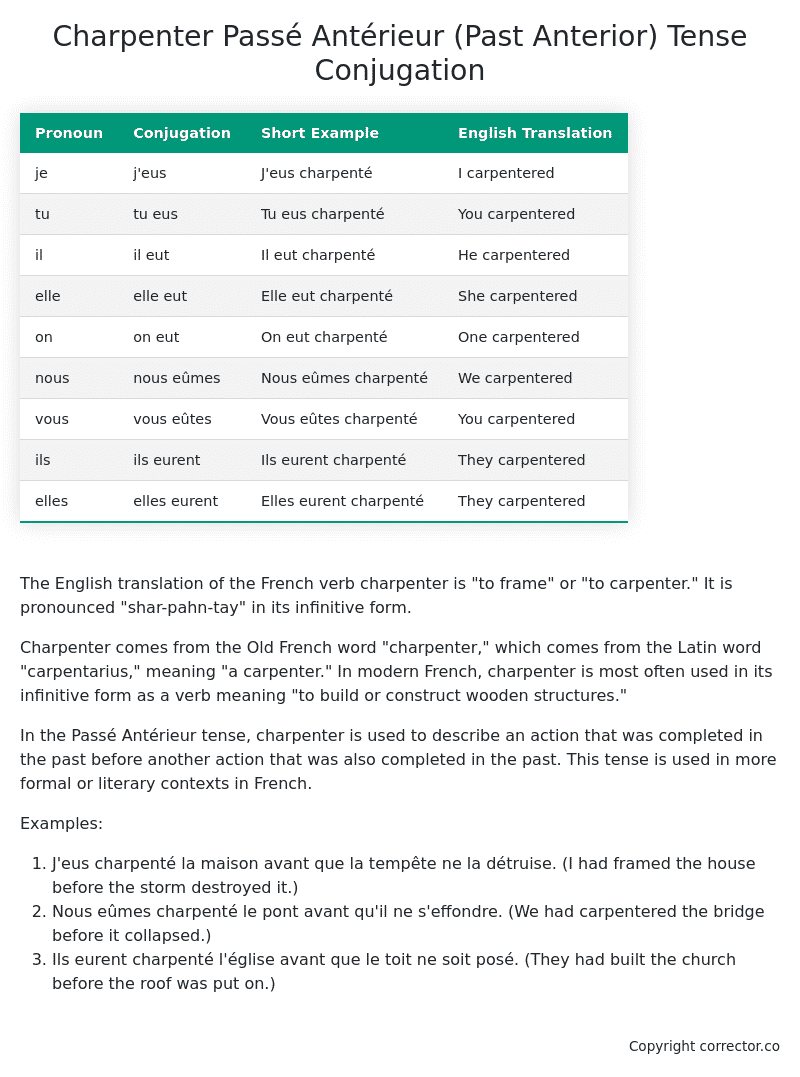Passé Antérieur (Past Anterior) Tense Conjugation of the French Verb charpenter
Introduction to the verb charpenter
The English translation of the French verb charpenter is “to frame” or “to carpenter.” It is pronounced “shar-pahn-tay” in its infinitive form.
Charpenter comes from the Old French word “charpenter,” which comes from the Latin word “carpentarius,” meaning “a carpenter.” In modern French, charpenter is most often used in its infinitive form as a verb meaning “to build or construct wooden structures.”
In the Passé Antérieur tense, charpenter is used to describe an action that was completed in the past before another action that was also completed in the past. This tense is used in more formal or literary contexts in French.
Examples:
- J’eus charpenté la maison avant que la tempête ne la détruise. (I had framed the house before the storm destroyed it.)
- Nous eûmes charpenté le pont avant qu’il ne s’effondre. (We had carpentered the bridge before it collapsed.)
- Ils eurent charpenté l’église avant que le toit ne soit posé. (They had built the church before the roof was put on.)
Table of the Passé Antérieur (Past Anterior) Tense Conjugation of charpenter
| Pronoun | Conjugation | Short Example | English Translation |
|---|---|---|---|
| je | j’eus | J’eus charpenté | I carpentered |
| tu | tu eus | Tu eus charpenté | You carpentered |
| il | il eut | Il eut charpenté | He carpentered |
| elle | elle eut | Elle eut charpenté | She carpentered |
| on | on eut | On eut charpenté | One carpentered |
| nous | nous eûmes | Nous eûmes charpenté | We carpentered |
| vous | vous eûtes | Vous eûtes charpenté | You carpentered |
| ils | ils eurent | Ils eurent charpenté | They carpentered |
| elles | elles eurent | Elles eurent charpenté | They carpentered |
Other Conjugations for Charpenter.
Le Present (Present Tense) Conjugation of the French Verb charpenter
Imparfait (Imperfect) Tense Conjugation of the French Verb charpenter
Passé Simple (Simple Past) Tense Conjugation of the French Verb charpenter
Passé Composé (Present Perfect) Tense Conjugation of the French Verb charpenter
Futur Simple (Simple Future) Tense Conjugation of the French Verb charpenter
Futur Proche (Near Future) Tense Conjugation of the French Verb charpenter
Plus-que-parfait (Pluperfect) Tense Conjugation of the French Verb charpenter
Passé Antérieur (Past Anterior) Tense Conjugation of the French Verb charpenter (this article)
Futur Antérieur (Future Anterior) Tense Conjugation of the French Verb charpenter
Subjonctif Présent (Subjunctive Present) Tense Conjugation of the French Verb charpenter
Subjonctif Passé (Subjunctive Past) Tense Conjugation of the French Verb charpenter
Subjonctif Imparfait (Subjunctive Imperfect) Tense Conjugation of the French Verb charpenter
Subjonctif Plus-que-parfait (Subjunctive Pluperfect) Tense Conjugation of the French Verb charpenter
Conditionnel Présent (Conditional Present) Tense Conjugation of the French Verb charpenter
Conditionnel Passé (Conditional Past) Tense Conjugation of the French Verb charpenter
L’impératif Présent (Imperative Present) Tense Conjugation of the French Verb charpenter
L’infinitif Présent (Infinitive Present) Tense Conjugation of the French Verb charpenter
Struggling with French verbs or the language in general? Why not use our free French Grammar Checker – no registration required!
Get a FREE Download Study Sheet of this Conjugation 🔥
Simply right click the image below, click “save image” and get your free reference for the charpenter Passé Antérieur tense conjugation!

Charpenter – About the French Passé Antérieur (Past Anterior) Tense
Formation of the Passé Antérieur
Common Usage Patterns
Literature
Historical Texts
Formal Writing
Interactions with Other Tenses
Passé Composé (Present Perfect)
Imparfait (Imperfect)
Futur Antérieur (Future Perfect)
Summary
I hope you enjoyed this article on the verb charpenter. Still in a learning mood? Check out another TOTALLY random French verb conjugation!


